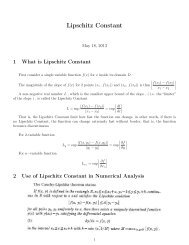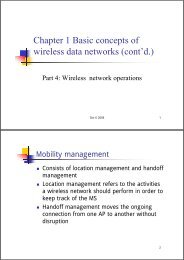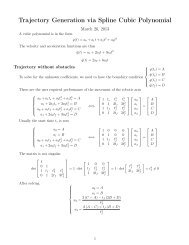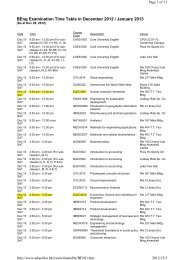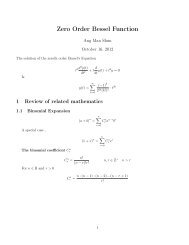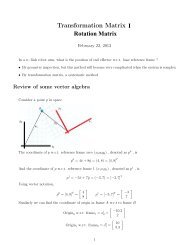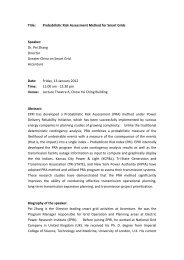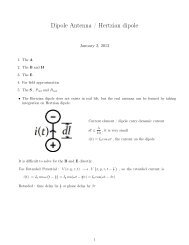Lithography - The University of Hong Kong
Lithography - The University of Hong Kong
Lithography - The University of Hong Kong
You also want an ePaper? Increase the reach of your titles
YUMPU automatically turns print PDFs into web optimized ePapers that Google loves.
ELEC 7364 Lecture Notes <br />
Summer 2008<br />
<strong>Lithography</strong><br />
by STELLA W. PANG<br />
from <strong>The</strong> <strong>University</strong> <strong>of</strong> Michigan, Ann Arbor, MI, USA<br />
Visiting Pr<strong>of</strong>essor at<br />
<strong>The</strong> <strong>University</strong> <strong>of</strong> <strong>Hong</strong> <strong>Kong</strong><br />
<strong>The</strong> <strong>University</strong> <strong>of</strong> Michigan – Visiting Pr<strong>of</strong>. HKU p. 1 S. W. Pang<br />
<strong>Lithography</strong> Requirements<br />
Resolution down to 24 nm<br />
Depth <strong>of</strong> Focus better than 0.5 µm<br />
Linewidth Control better than 4 nm<br />
Low Defect Density <strong>of</strong> 30/m 2 and Large Chip Size <strong>of</strong> 1600 mm 2 <br />
<strong>The</strong> <strong>University</strong> <strong>of</strong> Michigan – Visiting Pr<strong>of</strong>. HKU p. 2 S. W. Pang
<strong>Lithography</strong> Projection<br />
<br />
<br />
<br />
<br />
Photons with Short Wavelength<br />
EUV - Similar to X-Ray with High Energy Photons<br />
Masks are Difficult to Make Even with 4:1 or 10:1 Reduction<br />
Alternative <strong>Lithography</strong> Difficult to be Accepted<br />
<strong>The</strong> <strong>University</strong> <strong>of</strong> Michigan – Visiting Pr<strong>of</strong>. HKU p. 3 S. W. Pang<br />
<strong>Lithography</strong> - Mask to Patterns<br />
Mask Design and Layout with CAD Tools<br />
Mask Making by Direct Write: 1:1 up to 10:1<br />
Full Wafer Printing or Projection Printing <strong>of</strong> 1 Die at a Time<br />
High Throughput Needed (>50 Wafers/hr)<br />
<strong>The</strong> <strong>University</strong> <strong>of</strong> Michigan – Visiting Pr<strong>of</strong>. HKU p. 4 S. W. Pang
Optical <strong>Lithography</strong><br />
<strong>The</strong> <strong>University</strong> <strong>of</strong> Michigan – Visiting Pr<strong>of</strong>. HKU p. 5 S. W. Pang<br />
Optical <strong>Lithography</strong> Process<br />
<br />
<br />
<br />
<br />
Mask Design - CAD<br />
Files<br />
Optical Mask (Ni<br />
/Quartz)<br />
Photoresist Coating<br />
Exposure and<br />
Development<br />
<strong>The</strong> <strong>University</strong> <strong>of</strong> Michigan – Visiting Pr<strong>of</strong>. HKU p. 6 S. W. Pang
Photoresist<br />
Mostly organic polymer<br />
- properties change after exposure to radiation<br />
(photons, electrons, ions)<br />
- selective removal <strong>of</strong> exposed (positive) or<br />
unexposed (negative) area by development <br />
Photoresist Requirements<br />
- Resolution (L min ) <br />
- Sensitivity (Throughput)<br />
- Etch Resistance (Pattern Transfer)<br />
- Spectral response, contrast, adhesion, pin hole<br />
density, thickness variation, stability (Pattern<br />
Quality)<br />
<strong>The</strong> <strong>University</strong> <strong>of</strong> Michigan – Visiting Pr<strong>of</strong>. HKU p. 7 S. W. Pang<br />
Resist Preparation<br />
<br />
<br />
<br />
Cleaning – remove surface contamination; Organic<br />
solvents, Oxide Etch <br />
Dehydration – remove moisture on surface; Bake at<br />
HMDS on Si<br />
<br />
<br />
<br />
Si Surface is Terminated with Si-O-Si(CH 3 ) 3 instead <strong>of</strong> Si-OH<br />
Polymer Layer has better Adhesion to –CH 3 group<br />
More Uniform Coating and Better Adhesion <strong>of</strong> Photoresist<br />
<strong>The</strong> <strong>University</strong> <strong>of</strong> Michigan – Visiting Pr<strong>of</strong>. HKU p. 9 S. W. Pang<br />
Spin Coating <strong>of</strong> Resist<br />
<br />
<br />
Liquid applied, changed to uniform coating after<br />
spinning and baking<br />
Balance between Centrifugal Force, Viscosity<br />
Resistance, and Solvent Evaporation<br />
<strong>The</strong> <strong>University</strong> <strong>of</strong> Michigan – Visiting Pr<strong>of</strong>. HKU p. 10 S. W. Pang
Photoresist Thickness after Spinning<br />
T = KS α ( ηβ<br />
ω γ R 2 )1/ 3<br />
T - Photoresist Thickness<br />
S - % Solid in photoresist (affects η)<br />
η - Viscosity<br />
ω - Spin speed in angular velocity (2000-6000 rotation per min – rpm)<br />
R – € Radius <strong>of</strong> wafer<br />
S and η could vary as solvent is evaporated<br />
Spin time ~30 to 60 s<br />
<strong>The</strong> <strong>University</strong> <strong>of</strong> Michigan – Visiting Pr<strong>of</strong>. HKU p. 11 S. W. Pang<br />
Photoresist Spin Curve<br />
T~ω -n where 0.4
Pre-Bake or S<strong>of</strong>t-Bake<br />
Remove solvents (80-90 % removal)<br />
Release stress<br />
Improve adhesion<br />
Excessive: Reduce resist sensitivity<br />
Insufficient: Reduce Developer Contrast<br />
<strong>The</strong> <strong>University</strong> <strong>of</strong> Michigan – Visiting Pr<strong>of</strong>. HKU p. 13 S. W. Pang<br />
Exposure<br />
Control Exposure Does – e.g. 10-100 mJ/cm 2;<br />
depends on photoresist sensitivity and affects<br />
pr<strong>of</strong>ile and feature size<br />
Optical Radiation: g-line: 436 nm; i-line: 365<br />
nm; Excimer Laser: KrF – 248 nm; ArF – 193<br />
nm; <br />
F 2 – 157 nm; Immersion Lens with n>1<br />
Exposure modes: Contact printing; Proximity<br />
printing; Projection printing (step and scan<br />
with reduction); Direct Write<br />
<strong>The</strong> <strong>University</strong> <strong>of</strong> Michigan – Visiting Pr<strong>of</strong>. HKU p. 14 S. W. Pang
Projection vs. Contact/Proximity Printing<br />
<br />
<br />
Research Labs - Contact and Proximity Printing Since<br />
Systems are Cheaper, Smaller, and Easier to Use<br />
Industry - Projection Printing with High Throughput<br />
for High Reproducibility, Low Defects, and More<br />
Automation<br />
<strong>The</strong> <strong>University</strong> <strong>of</strong> Michigan – Visiting Pr<strong>of</strong>. HKU p. 15 S. W. Pang<br />
Contact and Proximity Printing<br />
<br />
<br />
<br />
1X Mask - High Resolution Features more Difficult to<br />
Make<br />
Contac Printing Could Generate Defects on Masks and<br />
Substrates<br />
Resolution is Reduced by Gap<br />
<strong>The</strong> <strong>University</strong> <strong>of</strong> Michigan – Visiting Pr<strong>of</strong>. HKU p. 16 S. W. Pang
Projection Printing<br />
4-10X Mask -<br />
Easier to Make<br />
Optimized for<br />
Resolution,<br />
Depth <strong>of</strong> Focus,<br />
Throughput<br />
Resolution<br />
improves by<br />
shorter<br />
Wavelength (λ)<br />
and Higher<br />
Numerical<br />
Aperture (NA)<br />
while Depth <strong>of</strong><br />
Focus becomes<br />
Worse<br />
<strong>The</strong> <strong>University</strong> <strong>of</strong> Michigan – Visiting Pr<strong>of</strong>. HKU p. 17 S. W. Pang<br />
Optics for Optical Projection<br />
Simple Ray Optics, assume light travels in straight rays<br />
Numerical Aperture (NA) <br />
€<br />
(n=1 in air)<br />
NA = D 2 f = n sinα<br />
NA determines how much light is transmitted or collected<br />
at the image plane, influence exposure time and<br />
resolution<br />
<strong>The</strong> <strong>University</strong> <strong>of</strong> Michigan – Visiting Pr<strong>of</strong>. HKU p. 18 S. W. Pang
Resolution<br />
Resolution and Depth <strong>of</strong> Focus<br />
l min = k λ <br />
NA<br />
k: 0.5 to 0.7; experimental<br />
parameter<br />
€<br />
Depth <strong>of</strong> Focus <br />
λ<br />
DOF = k '<br />
NA 2 k'~0.5<br />
€<br />
For λ=365 nm; NA=0.45; k=0.7; k'=0.5<br />
l min =0.57 µm; DOF=0.9 µm<br />
Trade<strong>of</strong>f between l min and DOF, with better resolution, DOF<br />
is less<br />
<strong>The</strong> <strong>University</strong> <strong>of</strong> Michigan – Visiting Pr<strong>of</strong>. HKU p. 19 S. W. Pang<br />
Fraunh<strong>of</strong>er<br />
Diffraction Pattern<br />
Through Circular<br />
Aperture<br />
Light Intensity on Wafer<br />
Modulation Transfer<br />
Function - High on<br />
Mask, Lower on Wafer<br />
Due to Optics<br />
Diffraction<br />
<strong>The</strong> <strong>University</strong> <strong>of</strong> Michigan – Visiting Pr<strong>of</strong>. HKU p. 20 S. W. Pang
Resist Development<br />
Typical Condition: 1 min, 20 °C in developer<br />
Selective resist removal based on<br />
- Chemical Transformation (e.g. carboxylic acid<br />
formation during positive resist exposure)<br />
- Change in MW (faster development for low MW<br />
polymer)<br />
<strong>The</strong> <strong>University</strong> <strong>of</strong> Michigan – Visiting Pr<strong>of</strong>. HKU p. 21 S. W. Pang<br />
<br />
<br />
<br />
Hard Bake or Post Bake<br />
Typical Condition: 10 min, 120 °C on Hot Plate<br />
Improves Etch Resistance and Adhesion, Prevents<br />
Swelling<br />
Resist Flows and Pr<strong>of</strong>ile becomes Tapered<br />
<strong>The</strong> <strong>University</strong> <strong>of</strong> Michigan – Visiting Pr<strong>of</strong>. HKU p. 22 S. W. Pang
2 Component Positive Resist<br />
Binder + Sensitizer; acid formed due to radiation<br />
which can be dissolved in base developer<br />
Resin/Binder (Novolac Co-polymer), >80 %<br />
- MW 500-20000, doesn't interact with radiation<br />
- Phenolic group, acidic, can be dissolved in base<br />
solution (~15 nm/s)<br />
- Structure and composition <strong>of</strong> polymer determine<br />
viscosity and developer solubility<br />
<strong>The</strong> <strong>University</strong> <strong>of</strong> Michigan – Visiting Pr<strong>of</strong>. HKU p. 23 S. W. Pang<br />
<br />
<br />
<br />
Sensitizer in 2 Component Positive Resist<br />
Sensitizer/Inhibitor (200 nm/s)<br />
Changes in Sensitizer due to exposure (chemical<br />
transformation)<br />
<strong>The</strong> <strong>University</strong> <strong>of</strong> Michigan – Visiting Pr<strong>of</strong>. HKU p. 24 S. W. Pang
Chemical Transformation <strong>of</strong> Positive Resist<br />
<br />
<br />
<br />
Sensitizer Activated by Photons - Chemical<br />
Transformation<br />
Release <strong>of</strong> N 2 <br />
Carboxylic Acid Form in Presence <strong>of</strong> H 2 O<br />
<strong>The</strong> <strong>University</strong> <strong>of</strong> Michigan – Visiting Pr<strong>of</strong>. HKU p. 25 S. W. Pang<br />
One Component Positive Resist<br />
PolyMethylMethacrylate (PMMA)<br />
MW 200-1000K, high resolution, low sensitivity<br />
Bond breaking (chain scission) due to exposure to radiation<br />
MW reduced and low MW polymer is removed during<br />
development<br />
<strong>The</strong> <strong>University</strong> <strong>of</strong> Michigan – Visiting Pr<strong>of</strong>. HKU p. 26 S. W. Pang
2 Component Negative Resist<br />
Cross linking to generate longer polymer chain with<br />
higher MW<br />
Non-planer solvent (e.g. Tolune, Xylene) removes low<br />
MW polymer (~100 nm/s); leaves behind high MW<br />
polymer (~1 nm/s)<br />
Rubber Matrix (~Resin)<br />
- Soluble in non-planar solution (e.g. Tolune,<br />
Xylene, ~100 nm/s)<br />
<strong>The</strong> <strong>University</strong> <strong>of</strong> Michigan – Visiting Pr<strong>of</strong>. HKU p. 27 S. W. Pang<br />
Sensitizer in 2 Component Negative Resist<br />
Sensitizer (R-N 3 )<br />
<br />
Free radicals generated when exposed to radiation,<br />
causing cross-linking <strong>of</strong> polymer. MW increased and<br />
low MW polymer is removed during development,<br />
leaving behind high MW polymer (exposed area)<br />
<strong>The</strong> <strong>University</strong> <strong>of</strong> Michigan – Visiting Pr<strong>of</strong>. HKU p. 28 S. W. Pang
Cross Linking <strong>of</strong> Negative Resist<br />
<br />
<br />
<br />
Reactive Radicals are generated by Radiation<br />
Release <strong>of</strong> N 2 <br />
Radicals Link up with Other Polymer Chains and Form<br />
new Compounds with Higher Molecular Weight<br />
<strong>The</strong> <strong>University</strong> <strong>of</strong> Michigan – Visiting Pr<strong>of</strong>. HKU p. 29 S. W. Pang<br />
One Component Negative Resist<br />
PolyMethylMethacrylate (PMMA)<br />
Cross linking occurs when dosage is<br />
high enough due to free radical<br />
accumulation that starts up chain<br />
reaction for cross linking<br />
<strong>The</strong> <strong>University</strong> <strong>of</strong> Michigan – Visiting Pr<strong>of</strong>. HKU p. 30 S. W. Pang
Improvements in Resist Technology<br />
Chemical Amplification (CA) Resist<br />
- High Sensitivity, High Contrast<br />
- Process harder to control, sensitive to<br />
contaminants in air, less etch resistance<br />
- Photon absorption causes decomposition <strong>of</strong><br />
Photoacid Generator (PAG), forming Acid,<br />
during post bake, inducing cascade <strong>of</strong> Chemical<br />
Transformations in Resist<br />
Multilayer Resist (Bilayer, Trilayer)<br />
- High Resolution, Better Etch Resistance with<br />
Thicker Resist, Planarization<br />
- More Complicated process with additional dry<br />
etching <strong>of</strong> bottom layer resist<br />
<strong>The</strong> <strong>University</strong> <strong>of</strong> Michigan – Visiting Pr<strong>of</strong>. HKU p. 31 S. W. Pang<br />
<br />
Silylated Resist<br />
Silylated Resist (Introduce Si in Polymer)<br />
- Use to increase etch resistance during O 2 plasma<br />
etching <strong>of</strong> bottom layer resist<br />
- Only a small amount <strong>of</strong> Si needed (
Resist Contrast and Sensitivity<br />
Resist Contrast depends on photoresist and UV property, affects<br />
resist pr<strong>of</strong>ile<br />
Development Curve (Contrast) For Positive Photoresist<br />
γ p<br />
=<br />
1<br />
log( D o<br />
D 1<br />
)<br />
e.g.<br />
<br />
<br />
Positive resist (AZ 1450J), 0.5 µm thick <br />
€<br />
D o =33 mJ/cm 2 ; D 1 =21 mJ/cm 2 ; γ=5.1 <br />
Large γ - more vertical resist pr<strong>of</strong>ile <br />
3 regions on development curve: <br />
A. Low Exposure - small but finite development rate (e.g. 1 nm/s) <br />
B. Medium Exposure - solubility increases with exposure dose <br />
C. High Exposure - resist fully removed when D≥ D o (e.g. 100 nm/s)<br />
<strong>The</strong> <strong>University</strong> <strong>of</strong> Michigan – Visiting Pr<strong>of</strong>. HKU p. 33 S. W. Pang<br />
<br />
<br />
Negative Resist Contrast<br />
Resist Contrast depends on photoresist and UV property, affects<br />
resist pr<strong>of</strong>ile<br />
Development Curve (Contrast) For Negative Photoresist<br />
γ n<br />
=<br />
1<br />
log( D 1<br />
D 0<br />
)<br />
Similar to Positive Photoresist development curve, but Reversed: <br />
A. Low Exposure - Fast development € rate <br />
B. Medium Exposure - solubility decreases with exposure dose <br />
C. High Exposure - resist will not be removed<br />
<strong>The</strong> <strong>University</strong> <strong>of</strong> Michigan – Visiting Pr<strong>of</strong>. HKU p. 34 S. W. Pang
Light Absorption and Sensitivity<br />
<br />
<br />
I = I o e -αz where α is absorption coefficient<br />
Less dose near bottom <strong>of</strong> resist, Could affect resist<br />
pr<strong>of</strong>ile<br />
Resist Sensitivity - minimum dose required to define<br />
patterns in resist <br />
- positive resist: S=D o , minimum dose needed to remove<br />
exposed resist<br />
- negative resist: S=D 2 , minimum dose needed to keep<br />
exposed resist at 50% thickness<br />
<strong>The</strong> <strong>University</strong> <strong>of</strong> Michigan – Visiting Pr<strong>of</strong>. HKU p. 35 S. W. Pang<br />
<br />
<br />
Resist Pr<strong>of</strong>ile<br />
Depends on resist contrast and exposure pr<strong>of</strong>ile<br />
Ideal pr<strong>of</strong>ile - Vertical<br />
dT<br />
dx = ∞<br />
€<br />
<strong>The</strong> <strong>University</strong> <strong>of</strong> Michigan – Visiting Pr<strong>of</strong>. HKU p. 36 S. W. Pang
€<br />
<br />
<br />
Calculate Resist Pr<strong>of</strong>ile<br />
From Development Curve<br />
T(D,x) = γT o<br />
log<br />
€<br />
Let Exposure Dose D(T ,x) = I(x)te −α (T o −T )<br />
Where I(x) = Light Intensity; t = Exposure Time<br />
Slope <strong>of</strong> Resist (Pr<strong>of</strong>ile) =<br />
€<br />
D o<br />
D(T, x)<br />
T(D,x)<br />
T o<br />
= γ log<br />
T(D,x) € = γT o<br />
[log<br />
I(x)te ]<br />
−α (T o −T )<br />
D o<br />
D(T ,x)<br />
<strong>The</strong> <strong>University</strong> <strong>of</strong> Michigan – Visiting Pr<strong>of</strong>. HKU p. 37 S. W. Pang<br />
dT<br />
dx<br />
D o<br />
€<br />
To Get Vertical Pr<strong>of</strong>ile<br />
Large contrast (γ)<br />
Small absorption (α) - get more light down to<br />
bottom <strong>of</strong> resist<br />
Little light scattering (large dI(x)/dx)<br />
High D o so that some <strong>of</strong> the scattered light will<br />
not expose resist<br />
Short exposure time to reduce scattering<br />
Thinner resist for less light scattering<br />
<strong>The</strong> <strong>University</strong> <strong>of</strong> Michigan – Visiting Pr<strong>of</strong>. HKU p. 38 S. W. Pang
Modulation Transfer Function (MTF)<br />
Ratio <strong>of</strong> modulation <strong>of</strong> an optical image to that<br />
<strong>of</strong> an object - represent image quality<br />
Depends on optical system and resist -<br />
wavelength, numerical aperture, contrast,<br />
light coherence, spatial frequency<br />
MTF (λ, NA, γ, S, f)<br />
<strong>The</strong> <strong>University</strong> <strong>of</strong> Michigan – Visiting Pr<strong>of</strong>. HKU p. 39 S. W. Pang<br />
Light Distribution and MTF<br />
<br />
Mask Modulation<br />
M mask<br />
= I m −max − I m −min<br />
I m −max<br />
+ I m −min<br />
<br />
Wafer Modulation<br />
If I min = 0, then M = 1; If I min ≠ 0, then M
MTF and Linewidth<br />
<br />
<br />
If γ = ∞ (vertical pr<strong>of</strong>ile), MTF affects linewidth<br />
Exposure Time Affects Dose - Linewidth for Positive<br />
Photoresist is Reduced for Longer Exposure Time<br />
<strong>The</strong> <strong>University</strong> <strong>of</strong> Michigan – Visiting Pr<strong>of</strong>. HKU p. 41 S. W. Pang<br />
Light Coherence and Resolution<br />
<br />
<br />
<br />
<br />
<br />
Resolution also depends on Light Coherence (S)<br />
Coherent Light (S = 0) – Light passes slit in 1 angle<br />
(point source)<br />
Incoherent Light (S = 1) – Light with different angles<br />
and phases<br />
f = spatial frequency; line and space, or period <strong>of</strong><br />
gratings = 1/2L<br />
f c = cut<strong>of</strong>f frequency, minimum feature size that can be<br />
defined<br />
<strong>The</strong> <strong>University</strong> <strong>of</strong> Michigan – Visiting Pr<strong>of</strong>. HKU p. 42 S. W. Pang
MTF - Pattern Transfer Quality<br />
<br />
<br />
<br />
<br />
<br />
MTF = 1: Sharp Transition from Light to Dark<br />
MTF = 0: No difference between I max and I min , can't<br />
form any patterns<br />
f<br />
Poor image quality at low MTF c<br />
= 2NA<br />
λ<br />
For Coherent light S=0: Lower resolution, better image<br />
quality (High MTF); MTF=1 for f≤0.5 f c <br />
For Partial Coherent or Incoherent light S>0: Higher<br />
€<br />
resolution, worse image quality; MTF>0 for f≤f c ;<br />
MTF=0 for f=f c <br />
<strong>The</strong> <strong>University</strong> <strong>of</strong> Michigan – Visiting Pr<strong>of</strong>. HKU p. 43 S. W. Pang<br />
MTF Needed For Given Feature Size<br />
Smallest features that can be patterned with <br />
λ=200 nm, NA=0.5:<br />
Can't work with MTF=0<br />
If resist requires MTF=0.6 MTF = 0.6 =<br />
or 2L=0.33 µm; f=3 lines/µm; or l min = 0.165 µm<br />
Below this resolution, image quality is so poor<br />
€<br />
that it is not useful (e.g. can't do 5 lines/µm at<br />
f c ; or l min = 0.1 µm)<br />
1<br />
2L ( f )<br />
2NA<br />
λ ( f c )<br />
<strong>The</strong> <strong>University</strong> <strong>of</strong> Michigan – Visiting Pr<strong>of</strong>. HKU p. 44 S. W. Pang
Phase Shifting Mask (PSM)<br />
Traditional<br />
Mask<br />
Phase Shifted<br />
Mask<br />
<br />
<br />
Make adjacent phases to be 180° out <strong>of</strong> phase with one another.<br />
This provides destructive interference and reduce diffraction,<br />
therefore reducing I min and increasing MTF with better contrast<br />
and resolution<br />
Resolution can be increased by 2 times or more depending on S<br />
<strong>The</strong> <strong>University</strong> <strong>of</strong> Michigan – Visiting Pr<strong>of</strong>. HKU p. 45 S. W. Pang<br />
Contrast Function<br />
I max<br />
− I min<br />
Contrast Function = I max<br />
+ I min<br />
at phase shifted image<br />
Improve Resolution using Same Optical System<br />
<strong>The</strong> <strong>University</strong> <strong>of</strong> Michigan – Visiting Pr<strong>of</strong>. HKU p. 46 S. W. Pang<br />
€
Phase Shifted Mask Formation<br />
d(n −1) = λ 2 ;n = c v<br />
d =<br />
λ<br />
2(n −1)<br />
<br />
<br />
<br />
Add a transparent layer (e.g. quartz/polymer) such that the<br />
adjacent apertures are 180° out <strong>of</strong> phase - Optical thickness<br />
shifted by λ /2 €<br />
Need to take into account all adjacent features<br />
For phase shifted mask<br />
- Higher light intensity in exposed area, less residue left<br />
behind after development<br />
- Lower light intensity in unexposed area, larger process<br />
window for over-exposure, better resist pr<strong>of</strong>ile, and less<br />
undercutting<br />
- Intense computation needed for mask design to account for<br />
all adjacent apertures.<br />
- Significant improvement in resolution<br />
<strong>The</strong> <strong>University</strong> <strong>of</strong> Michigan – Visiting Pr<strong>of</strong>. HKU p. 47 S. W. Pang<br />
Next Generation <strong>Lithography</strong><br />
Non-Optical <strong>Lithography</strong><br />
Resolution limit - 100 nm and below<br />
Extreme UV (EUV) Reflective Projection<br />
Xray <strong>Lithography</strong> (XRL)<br />
Electron Beam <strong>Lithography</strong> (EBL)<br />
Nanoimprint <strong>Lithography</strong> (NIL)<br />
<strong>The</strong> <strong>University</strong> <strong>of</strong> Michigan – Visiting Pr<strong>of</strong>. HKU p. 48 S. W. Pang
Extreme UV (EUV) Reflective Projection<br />
<br />
<br />
<br />
<br />
S<strong>of</strong>t Xray - λ=10-15 nm; photon energy ~100 eV<br />
All Vacuum, all reflective optics<br />
EUV Source - High power laser (Nd-YAG) to heat up<br />
supersonic Xe jet to produce EUV<br />
Reflective Optics - >50 multiple layers <strong>of</strong> thin films <strong>of</strong><br />
dissimilar n and α to form optical interference and<br />
high reflectivity (e.g. Mo/Si). Layer thickness=λ/4<br />
- e.g. Mo/Si with Layer thickness = λ/4 <br />
- Need better than 0.01 nm thickness control and<br />
0.3 nm smoothness<br />
- improved reflectivity (from ~50% to >70%)<br />
- no damage for long exposure time<br />
<strong>The</strong> <strong>University</strong> <strong>of</strong> Michigan – Visiting Pr<strong>of</strong>. HKU p. 49 S. W. Pang<br />
EUV SYSTEM AND MASK<br />
<br />
<br />
All Reflective Optics with Multiple Mirrors for<br />
Reduction<br />
Mirrors and Mask with Alternating Layers <strong>of</strong> High and<br />
Low Mass Materials for Constructive Interference<br />
<strong>The</strong> <strong>University</strong> <strong>of</strong> Michigan – Visiting Pr<strong>of</strong>. HKU p. 50 S. W. Pang
EUV System<br />
Projection system with 4-10X reduction<br />
Scanning mask and wafer<br />
Small NA (e.g. 0.25) with large DOF<br />
Could have large process window such that<br />
Phase Shifting Mask (PSM) or Optical<br />
Proximity Correction (OPC) is not needed<br />
Closer to Optical <strong>Lithography</strong><br />
<strong>The</strong> <strong>University</strong> <strong>of</strong> Michigan – Visiting Pr<strong>of</strong>. HKU p. 51 S. W. Pang<br />
EUV vs. Optical <strong>Lithography</strong><br />
193 nm DUV is Used - Pushed As Far As<br />
Possible<br />
- Phase-Shifted Masks <br />
- Double Exposure<br />
- High Index Lens Immersion<br />
- Below 32 nm<br />
EUV Concerns<br />
- Control <strong>of</strong> Mo/Si Layer Thickness (
Xray <strong>Lithography</strong> (XRL)<br />
Short wavelength Xray - λ=1 nm; photon energy <br />
~10 KeV<br />
All Vacuum, membrane mask based on xray<br />
absorption<br />
Xray Sources - Laser or Plasma Generated Xray<br />
source<br />
- Heat up target (e.g. Fe-Ni) by high intensity laser<br />
or heat up gases by electromagnetic wave to<br />
generate high temperature plasma that emits<br />
xray. Pulsed laser or EM power is <strong>of</strong>ten used<br />
- ~10% efficient. Need to increase source<br />
brightness<br />
- Need to reduce debris from plasma using<br />
shielding or <strong>of</strong>f center excitation<br />
- Xray pulses with very high power for short time<br />
can damage mask/sample. Better to have lower<br />
power but high repetition rate<br />
<strong>The</strong> <strong>University</strong> <strong>of</strong> Michigan – Visiting Pr<strong>of</strong>. HKU p. 53 S. W. Pang<br />
Compact Synchrotron or Electron Storage Ring<br />
Particle accelerator with magnetic<br />
confinement and electrons are accelerated in<br />
a ring close to speed <strong>of</strong> light (~1 GeV)<br />
Xray emits from tangent <strong>of</strong> curved trajectory.<br />
Can get multiple exposure stations (~25) from<br />
1 ring<br />
Emitted Xray: Broad Spectrum emission, need<br />
filtering for exposure<br />
Bright source with high throughput and high<br />
resolution<br />
Expensive (>25 M) and needs backup system<br />
Large floor space, concern about downtime<br />
and reliability<br />
<strong>The</strong> <strong>University</strong> <strong>of</strong> Michigan – Visiting Pr<strong>of</strong>. HKU p. 54 S. W. Pang
Xray Mask<br />
<br />
<br />
<br />
Materials for absorber and membrane depend on α<br />
Concerns about Xray Mask and Exposure<br />
- Thick absorber with high α and thin membrane with low α<br />
for high mask contrast. Difficult to pattern thick absorber,<br />
thin membrane is less stable<br />
- Membrane need to be transparent in visible light for<br />
alignment<br />
- Need resist with high sensitivity for high throughput and<br />
low α to expose thick layer<br />
Advantages <strong>of</strong> XRL<br />
- High resolution due to short λ<br />
- High throughput compared to direct writing<br />
- No proximity correction needed<br />
- Immune to low MW particles with low α (e.g. dust)<br />
<strong>The</strong> <strong>University</strong> <strong>of</strong> Michigan – Visiting Pr<strong>of</strong>. HKU p. 55 S. W. Pang<br />
High Resolution Xray Mask<br />
<br />
<br />
Angle Evaporation on Sidewalls and Top Surface with Alternative<br />
Layers <strong>of</strong> High/Low MW<br />
Linewidth Controlled by Layer Thickness<br />
<strong>The</strong> <strong>University</strong> <strong>of</strong> Michigan – Visiting Pr<strong>of</strong>. HKU p. 56 S. W. Pang
Electron Beam <strong>Lithography</strong> (EBL)<br />
Very short wavelength λ=0.01 to 0.05 nm,<br />
depending on electron energy<br />
λ(nm) =<br />
0.039<br />
V(keV )<br />
Electron energy~10-50 KeV<br />
<br />
€<br />
All Vacuum, either direct write or projection<br />
electron beam through membrane mask<br />
<strong>The</strong> <strong>University</strong> <strong>of</strong> Michigan – Visiting Pr<strong>of</strong>. HKU p. 57 S. W. Pang<br />
Direct Write EBL<br />
<br />
<br />
<br />
Input computer designs and generate patterns by<br />
scanning electron beam<br />
Need electron source with high brightness (e.g. field<br />
emission source rather than thermionic emission<br />
source) for high throughput<br />
Need good lens system to focus down to small beam<br />
size<br />
<strong>The</strong> <strong>University</strong> <strong>of</strong> Michigan – Visiting Pr<strong>of</strong>. HKU p. 58 S. W. Pang
Distortions in EBL<br />
Astigmation - misalignment <strong>of</strong> lenses that causes<br />
beam shape to change; Can be corrected by<br />
magnetic lenses<br />
<br />
Spherical Aberration - electrons land at different spots<br />
(focus points) due to their entry through lens from<br />
different point <strong>of</strong>f central axis. Increase minimum<br />
spot size<br />
<strong>The</strong> <strong>University</strong> <strong>of</strong> Michigan – Visiting Pr<strong>of</strong>. HKU p. 59 S. W. Pang<br />
<br />
Distortions in EBL<br />
Astigmation - misalignment <strong>of</strong> lenses that causes<br />
beam shape to change; Can be corrected by<br />
magnetic lenses<br />
<br />
Spherical Aberration - electrons land at different spots<br />
(focus points) due to their entry through lens from<br />
different point <strong>of</strong>f central axis. Increase minimum<br />
spot size<br />
<strong>The</strong> <strong>University</strong> <strong>of</strong> Michigan – Visiting Pr<strong>of</strong>. HKU p. 60 S. W. Pang
Additional Distortions in EBL<br />
Chromatic Aberration - due to energy spread <strong>of</strong><br />
electrons. Slower electrons are brought to focus<br />
closer to lens than faster electrons; Increase<br />
minimum spot size<br />
<br />
Spot size also depends on Mutual Columbic Repulsion<br />
<strong>of</strong> electrons and Diffraction limit <strong>of</strong> electrons<br />
<strong>The</strong> <strong>University</strong> <strong>of</strong> Michigan – Visiting Pr<strong>of</strong>. HKU p. 61 S. W. Pang<br />
<br />
<br />
Feature Size by EBL<br />
Once a beam gets minimum spot size through lenses,<br />
feature size limitation depends on electron scattering<br />
in resist and substrate<br />
Electrons scatter around until energy is lost or exit<br />
through resist surface by backscattering - Resolution<br />
depends on resist thickness due to scattering<br />
<strong>The</strong> <strong>University</strong> <strong>of</strong> Michigan – Visiting Pr<strong>of</strong>. HKU p. 62 S. W. Pang
Electron Penetration Range<br />
Monte Carlo simulation is used to track<br />
electron paths - Most electron energy is<br />
absorbed in substrate<br />
Maximum electron penetration range<br />
R(cm) = 4.6x10−6<br />
ρ<br />
V(keV ) 1.75<br />
e.g. ρ=1 g/cm 3 ; V=25 KeV; R g =12.9 µm<br />
€<br />
<strong>The</strong> <strong>University</strong> <strong>of</strong> Michigan – Visiting Pr<strong>of</strong>. HKU p. 63 S. W. Pang<br />
Proximity Effect<br />
<br />
Amount <strong>of</strong> Dose depends on position and shape <strong>of</strong><br />
features and their neighbors - Proximity correction by<br />
exposure dose adjustment using computer s<strong>of</strong>tware<br />
to calculate dosage from all adjacent features<br />
<strong>The</strong> <strong>University</strong> <strong>of</strong> Michigan – Visiting Pr<strong>of</strong>. HKU p. 64 S. W. Pang
Early Imprint <strong>Lithography</strong><br />
• ~1040 Movable Clay, Ceramic, and Wooden type Invented in<br />
China<br />
• ~1440 Gutenberg in Germany Commenced work on his<br />
Printing press with Metal moving type<br />
Woodblock<br />
Edition <strong>of</strong><br />
Chinese Play<br />
Gutenberg<br />
Press<br />
<strong>The</strong> <strong>University</strong> <strong>of</strong> Michigan – Visiting Pr<strong>of</strong>. HKU p. 65 S. W. Pang<br />
Types <strong>of</strong> Imprint <strong>Lithography</strong><br />
Hot Embossing – <strong>The</strong>rmoplastic<br />
– Polymer Flows above Glass Transition<br />
Temperature under Pressure<br />
Step and Flash Imprint <strong>Lithography</strong> (SFIL) – UV<br />
Assisted<br />
– UV Curable Polymer Flows and Solidifies after<br />
UV Exposure<br />
Reversal Nanoimprint <strong>Lithography</strong> – with and without<br />
UV, Mold Coating, and Transfer to Substrate<br />
– Multiple Imprints to Generate 3D Nanostructures<br />
– Low Temperature and Low Pressure<br />
– Flexible: no Residual Layer, no Liquid Fill<br />
<strong>The</strong> <strong>University</strong> <strong>of</strong> Michigan – Visiting Pr<strong>of</strong>. HKU p. 66 S. W. Pang
Applications <strong>of</strong> Imprint <strong>Lithography</strong><br />
Semiconductor Integrated Circuits<br />
– Mix and Match with Optical <strong>Lithography</strong><br />
Hard Disk Drives<br />
– High Resolution, High Density, Double-Sided,<br />
and Low Cost<br />
Light Emitting Diodes and Flat Panel Displays<br />
– High Resolution, High Density, Large Area, and<br />
Low Cost<br />
Biomedical Systems<br />
– High Resolution, High Density, Large Area, 3D<br />
Fluidic System, and Low Cost<br />
<strong>The</strong> <strong>University</strong> <strong>of</strong> Michigan – Visiting Pr<strong>of</strong>. HKU p. 67 S. W. Pang<br />
Full Wafer Imprint<br />
Imprint Throughput<br />
– Imprint Large Area (8 inch diameter) with High<br />
Throughput<br />
– Need Uniform Pressure between Mold and<br />
Substrate such as Air Cushion Pressure<br />
Step and Repeat Imprint<br />
– Similar to Optical <strong>Lithography</strong>, Easier to Control<br />
– Easier to make Imprint Mold with Smaller Area<br />
– Lower Throughput<br />
<strong>The</strong> <strong>University</strong> <strong>of</strong> Michigan – Visiting Pr<strong>of</strong>. HKU p. 68 S. W. Pang
Concerns <strong>of</strong> Imprint <strong>Lithography</strong> - I<br />
Patterning<br />
– High Resolution Tools Needed<br />
– Line Width Roughness Induced by <strong>Lithography</strong><br />
and Etching<br />
– Uniform Residual Layer<br />
1X Mold<br />
– CD Control<br />
– High Cost for Master – Multiple Molds can be<br />
Duplicated by Imprinting<br />
<strong>The</strong> <strong>University</strong> <strong>of</strong> Michigan – Visiting Pr<strong>of</strong>. HKU p. 69 S. W. Pang<br />
Concerns <strong>of</strong> Imprint <strong>Lithography</strong> - II<br />
Overlay<br />
– 3 Sigma <strong>of</strong> 10 nm Needed<br />
– Easier with Step and Scan than Full Wafer<br />
Imprint<br />
Defects<br />
– Contact between Mold and Substrate<br />
– Mold Cleaning and Defect Removal<br />
– Avoid Trapped Air by Using Vacuum, Flat Molds<br />
/Substrates, Spin-Coating rather than<br />
Dispensing<br />
– Lower Pressure to Avoid Mold Damage<br />
<strong>The</strong> <strong>University</strong> <strong>of</strong> Michigan – Visiting Pr<strong>of</strong>. HKU p. 70 S. W. Pang
MODES OF REVERSAL IMPRINTING<br />
<br />
<br />
<br />
<br />
NIL <br />
T>>T g <br />
CONVENTIONAL<br />
IMPRINT<br />
Embossing Inking<br />
Whole-Layer Transfer<br />
T>>T g <br />
T~T<br />
T~T g , non-planar g , planarized<br />
COATING ON MOLD<br />
3 IMPRINT MODES<br />
DEPENDS ON TEMPERATURE, PRESSURE,<br />
AND PLANARIZATION<br />
X. D. Huang, L.-R. Bao, X. Cheng, L. J. Guo, S. W. Pang, and A. F. Yee, J. Vac. Sci. Technol. B 20,<br />
2872-2876 (2002). <br />
<strong>The</strong> <strong>University</strong> <strong>of</strong> Michigan – Visiting Pr<strong>of</strong>. HKU p. 71 S. W. Pang<br />
HARD INERT SiC MOLDS FOR NANOIMPRINTING<br />
C 2 F 2 /O 2 30/10 sccm, 150 W rf POWER, -350 V, 6 Pa<br />
ETCH RATES: SiC 30 nm/min; Cr/Ni 0.8 nm/min; RESIST 200 nm/min<br />
ARRAYS OF DOTS IN SiC<br />
DEPTH = 320 nm 600 nm<br />
DEPTH = 800 nm<br />
GAP = 50 nm<br />
WIDTH = 100 nm<br />
High Aspect Ratio 8:1<br />
S. W. PANG, T. TAMAMURA, M. NAKAO, A. OZAWA, AND H. MASUDA, J. VAC. SCI.<br />
TECHNOL. B 16, 1145 (1998).<br />
<strong>The</strong> <strong>University</strong> <strong>of</strong> Michigan – Visiting Pr<strong>of</strong>. HKU p. 72 S. W. Pang
IMPRINTING ON METAL AND CERAMIC<br />
Nanoimprint Directly into Al<br />
Combine <strong>Lithography</strong> and Pattern<br />
Transfer <br />
SiC Mold with 40 nm Nanostructures<br />
4 µm Wide, 25 µm Deep CERAMIC Imprinted<br />
at 20 MPa, 30 s Using Polyimide MOLD<br />
Ceria-Zircronia Ceramic For Ultrasonic<br />
Imaging With High Resolution<br />
1 µm<br />
40 nm DOTS<br />
75 µm<br />
SINTERED at 1500 °C, 60 min<br />
DEPTH = 25 µm<br />
J. A. Bride, S. Baskaran, N. Taylor, J. W. Halloran, W. H. Juan, S. W. Pang, AND M. O'Donnell, Appl.<br />
Phys. Lett. 63, 3379-3381 (1993).<br />
<strong>The</strong> <strong>University</strong> <strong>of</strong> Michigan – Visiting Pr<strong>of</strong>. HKU p. 73 S. W. Pang<br />
MULTIPLE STEPS IN Al BY SINGLE<br />
NANOIMPRINTING<br />
THREE DEPTHS OF 100, 200, AND 300 nm<br />
500 µm<br />
x 20 µm/div; z 500 nm/div<br />
x 5 µm/div; z 500 nm/div<br />
S. W. Pang, T. Tamamura, M. Nakao, A. Ozawa, and H. Masuda, J. Vac. Sci. Technol. <br />
B 16, 1145-1149 (1998).<br />
<strong>The</strong> <strong>University</strong> <strong>of</strong> Michigan – Visiting Pr<strong>of</strong>. HKU p. 74 S. W. Pang
IMPRINTING ON FLEXIBLE SUBSTRATE<br />
50 µm THICK FLEXIBLE KAPTON FILM<br />
IMPRINT AT 175 °C<br />
<br />
<br />
<br />
ESPECIALLY SUITABLE FOR SUBSTRATES THAT<br />
CANNOT BE EASILY SPIN-COATED<br />
FLEXIBLE POLYMER FILMS<br />
PLASTIC ELECTRONICS<br />
<strong>The</strong> <strong>University</strong> <strong>of</strong> Michigan – Visiting Pr<strong>of</strong>. HKU p. 75 S. W. Pang<br />
THREE MODES OF REVERSAL IMPRINTING<br />
<br />
200<br />
Imprinting Temp. ( o C)<br />
180<br />
<br />
160<br />
140<br />
120<br />
<br />
Embossing<br />
Transition<br />
Whole-layer<br />
Inking<br />
Whole-Layer<br />
Transition<br />
Embossing<br />
Inking<br />
Tg<br />
100<br />
80<br />
60<br />
0 50 100 150 200 250 300 350<br />
R max<br />
(nm)<br />
<strong>The</strong> <strong>University</strong> <strong>of</strong> Michigan – Visiting Pr<strong>of</strong>. HKU p. 76 S. W. Pang
PATTERNING OVER TOPOGRAPHY<br />
SUSPENDED OR SUPPORTED NANOSTRUCTURES<br />
<br />
DEPENDING ON POLYMER PROPERTIES, IMPRINT<br />
CONDITIONS, AND PATTERN DIMENSIONS<br />
5-10 µm Gaps 2-5 µm Gaps<br />
<br />
<br />
POLYCARBONATE<br />
PMMA<br />
TOUGHER POLYMER MORE BRITTLE POLYMER<br />
L.-R. Bao, X. Cheng, X. D. Huang, L. J. Guo, S. W. Pang, and A. F. Yee, J. Vac. Sci. Technol. B 20,<br />
2881-2886 (2002). <br />
<strong>The</strong> <strong>University</strong> <strong>of</strong> Michigan – Visiting Pr<strong>of</strong>. HKU p. 77 S. W. Pang<br />
THREE-DIMENSIONAL NANOSTRUCTURES<br />
<br />
<br />
MULTIPLE IMPRINTS OF POLYMERS PATTERNS<br />
CAN TO USED TO FORM STACKED POLYMER LAYERS<br />
WITH SIMILAR OR DIFFERENT PROPERTIES<br />
<br />
<br />
<br />
<br />
<strong>The</strong> <strong>University</strong> <strong>of</strong> Michigan – Visiting Pr<strong>of</strong>. HKU p. 78 S. W. Pang
MULTIPLE LAYER 3D NANOSTRUCTURES<br />
3D PATTERNING BY REPEATED IMPRINTING<br />
<br />
<br />
L.-R. Bao, X. Cheng, X. D. Huang, L. J. Guo, S. W. Pang, and A. F. Yee, J. Vac. Sci. Technol. B 20,<br />
2881-2886 (2002). <br />
<strong>The</strong> <strong>University</strong> <strong>of</strong> Michigan – Visiting Pr<strong>of</strong>. HKU p. 79 S. W. Pang<br />
SELECTIVE SU-8 POSTS TRANSFER BY<br />
REVERSAL UV IMPRINT<br />
2 s Exposure; Bake: 65 °C 1 min, 95 °C 5 min; 1 min Development<br />
Reversal UV Imprint: 80 °C, 5 MPa, 1 min; 1 s UV Exposure; 80 °C, 5 MPa, 1 min<br />
1.3 µm Diameter Posts Selectively Transferred to 5 µm Wide, 300 nm Deep SU-8 Gratings<br />
1 µm 1 µm<br />
Polymer Posts Transferred Selectively only to Top <strong>of</strong> Gratings<br />
Allows Complex Structures Formation on Selected Areas<br />
C. Peng and S. W. Pang, J. Vac. Sci. Technol. B 24, 2968-2972 (2006).<br />
<strong>The</strong> <strong>University</strong> <strong>of</strong> Michigan – Visiting Pr<strong>of</strong>. HKU p. 80 S. W. Pang
LOW TEMPERATURE AND LOW PRESSURE REVERSAL UV<br />
NANOIMPRINT TO FORM SEALED CHANNELS<br />
Quartz<br />
SU-8<br />
UV<br />
Si<br />
Si<br />
a. Coating SU-8 on Quartz b. Imprint with UV<br />
Quartz<br />
Cured SU-8<br />
Si<br />
c. Coating Thin SU-8 Adhesion<br />
Layer on Si Substrate<br />
u<br />
Quartz<br />
Cured SU-8<br />
SU-8<br />
<br />
<br />
<br />
UV<br />
Quartz<br />
Cured SU-8<br />
Cured SU-8<br />
Si<br />
u<br />
Si<br />
d. Imprint with UV e. Formation <strong>of</strong> Channels<br />
in SU-8<br />
Sealed Channels Formation by Reversal Imprint with UV Exposure<br />
Low Temperature (55 °C) and Low Pressure (2 MPa) Used for Reversal<br />
Imprint<br />
Top SU-8 Layer UV-Cured before Reversal Imprint, Resulting in Good<br />
Channel Pr<strong>of</strong>ile Control Because No SU-8 Flow<br />
<strong>The</strong> <strong>University</strong> <strong>of</strong> Michigan – Visiting Pr<strong>of</strong>. HKU p. 81 S. W. Pang<br />
4 LAYER OF STACKED NANOCHANNELS<br />
1. Pattern SU-8 Coated Glass by UV Imprint: 55 °C, 1 MPa, 2 s UV<br />
2. Transfer Patterned SU-8 to Si Substrate with Thin SU-8 Adhesion Layer by<br />
Reversal UV Imprint: 55 °C, 2 MPa, 2 s UV<br />
3. Repeat Above Processes to Fabricate 3D Multiple Level Nanochannels<br />
400 nm Channels 200 nm Channels<br />
400 nm Channels 200 nm Channels<br />
Good Channel Pr<strong>of</strong>ile with 4 Repeated Reversal Imprints<br />
Uniform Array and Multiple Levels <strong>of</strong> 3D Nanochannels Formed by<br />
Repeating Reversal UV Nanoimprint<br />
B. Yang and S. W. Pang, J. Vac. Sci. Technol. B 24, 2984-2987 (2006).<br />
<strong>The</strong> <strong>University</strong> <strong>of</strong> Michigan – Visiting Pr<strong>of</strong>. HKU p. 82 S. W. Pang
REVERSAL IMPRINT TO TRANSFER METAL<br />
PATTERNING OVER NANOSTRUCTURES<br />
- COAT SU-8, METAL,<br />
AND PO LYMER<br />
ON GLASS MOLD<br />
(a )<br />
Glas s<br />
SU-8<br />
Metal<br />
Polym er<br />
Glass<br />
SU-8<br />
Metal<br />
Polymer<br />
- PATTERN POLYMER AND<br />
METAL BY LITHOGRAPHY<br />
AND ETCHING<br />
(b)<br />
A: IMPRINT TO Si<br />
B: IMPRINT TO SU-8<br />
Glass<br />
SU-8<br />
Metal<br />
Polymer<br />
Si<br />
Glass<br />
SU-8<br />
Metal<br />
SU-8<br />
Si<br />
- REVERSAL IMPRINT<br />
(c1)<br />
- REV ERSAL IMPRINT<br />
(c2)<br />
Metal<br />
Polym er<br />
Si<br />
Metal<br />
SU-8<br />
Si<br />
- SE PARATE MOLD<br />
(d1)<br />
- SEP ARATE MOLD<br />
(d2)<br />
<br />
<br />
Glass Mold with Cured SU-8 Layer and Etched Metal Patterns<br />
Metal Patterns Directly Transferred to Substrate Structures<br />
<strong>The</strong> <strong>University</strong> <strong>of</strong> Michigan – Visiting Pr<strong>of</strong>. HKU p. 83 S. W. Pang<br />
PATTERNED 3D METAL STRUCTURES FORMING<br />
CHANNELS WITH SUBSTRATE<br />
Glass Mold: SU-8 Gratings with 5 µm Period, 270 nm Deep, 2.5 µm Thick and<br />
0.5 µm Al Patterned by <strong>Lithography</strong> and Etching<br />
Reversal UV Imprint: 80 °C, 5 MPa, 1 min; 1 s UV Exposure; 80 °C, 5 MPa, 1 min <br />
SU-8 Gratings on Si Substrate: 5 µm Period, 340 nm Deep, 3.5 µm Thick<br />
Al Gratings<br />
<br />
SU-8 Gratings<br />
1 µm<br />
3D Channels with Interconnects Fabricated Using Structures in Mold,<br />
Patterning and Etching <strong>of</strong> Metal, and Structures on Substrate<br />
C. Peng and S. W. Pang, IEEE Inter. Conf. Nanotechnology, Cincinnati, Ohio, July 2006.<br />
<strong>The</strong> <strong>University</strong> <strong>of</strong> Michigan – Visiting Pr<strong>of</strong>. HKU p. 84 S. W. Pang
IMPRINTED 3-D GRATING WITH SEALED CAVITIES<br />
Duo Mold Imprinting<br />
Polymer Coating on Low Surface Energy Mold<br />
Surface Area also Determines Surface Adhesion<br />
Grating<br />
Grating<br />
Closed<br />
Cavities<br />
Si<br />
Closed Si<br />
1 µm<br />
Cavities<br />
1 µm<br />
FDTS Treated<br />
(Low Surface<br />
Energy)<br />
FDTS Treated<br />
(Low Surface<br />
Energy)<br />
Material: PMMA (Mw ∼15k)<br />
Both Molds (700 nm Period<br />
Mold and Square Mold)<br />
Treated With FDTS<br />
Imprinted at 5 MPa and <br />
150 °C<br />
Transferred to Substrate at 2<br />
MPa and 80 °C<br />
Y. P. <strong>Kong</strong>, H. Y. Low, S. W. Pang, and A. F. Yee, J. Vac. Sci. Technol. B 22, 3251-3256 (2004). <br />
<strong>The</strong> <strong>University</strong> <strong>of</strong> Michigan – Visiting Pr<strong>of</strong>. HKU p. 85 S. W. Pang<br />
SURFACE ENERGY MODIFIED BY SEQUENTIAL SILANE<br />
TREATMENTS<br />
Polymer Adheres to Mold With Higher Surface Energy<br />
PEDS- FDTS<br />
Treated Mold<br />
(Medium Surface Energy)<br />
Surface Treatment<br />
FDTS b <br />
PEDS c -FDTS<br />
PEDS<br />
Surface Energy a <br />
(MJ/m 2 )<br />
11.8 ± 0.3<br />
18.3 ± 0.4<br />
37.6 ± 0.9 <br />
a By contact angles and the geometric-mean method<br />
b Perfluorodecyltrichlorosilane<br />
FDTS<br />
Treated Mold<br />
(Low Surface Energy)<br />
c Phenethylmethyldichlorosilane<br />
Adhesion - Higher Surface Energy<br />
Release - Lower Surface Energy<br />
Surface energy difference<br />
~6.5 mJ/m 2<br />
Y. P. <strong>Kong</strong>, H. Y. Low, S. W. Pang, and A. F. Yee, J. Vac. Sci. Technol. B 22, 3251-3256 (2004). <br />
<strong>The</strong> <strong>University</strong> <strong>of</strong> Michigan – Visiting Pr<strong>of</strong>. HKU p. 86 S. W. Pang
SURFACE PROPERTIES OF Si TREATED WITH SILANES<br />
Sample<br />
Lower Surface Energy for FDTS Treated Surface<br />
than PETS or MOPTS Treatment<br />
Contact angle<br />
for H 2<br />
O<br />
Contact angle<br />
for CH 2<br />
I 2<br />
Surface energy (mJ/m 2 )<br />
γ s<br />
O 2<br />
Plasma 26.9 47.7 65.2<br />
PETS 108.1 69.9 23.4<br />
MOPTS 73.6 58.7 34.6<br />
FDTS 103.0 99.8 11.7<br />
PETS (PhenEthyl TrichloroSilane)<br />
MOPTS (Methacryl Oxypropylene TrichloroSilane)<br />
FDTS (1H,1H,2H,2H-perFluoroDecyl TrichloroSilane)<br />
Si C 2 H 4<br />
Cl<br />
CF 3<br />
(CF 2 ) 7 C 2 H 4 Si<br />
Cl<br />
O<br />
CH 2 C C O C 3 H 6<br />
CH 3<br />
Cl<br />
Surface Energy Can be Controlled by Various Surface Treatments<br />
Silanes Can be Mixed in Various Ratio for Desired Surface Energy<br />
L.-R. Bao, L. Tan, X. D. Huang, Y. P. <strong>Kong</strong>, L. J. Guo, S. W. Pang, and A. F. Yee, J. Vac. Sci. Technol. B 21, 2749 (2003).<br />
<strong>The</strong> <strong>University</strong> <strong>of</strong> Michigan – Visiting Pr<strong>of</strong>. HKU p. 87 S. W. Pang<br />
Cl<br />
Cl<br />
Cl<br />
Si<br />
Cl<br />
Cl<br />
Cl<br />
Example <strong>of</strong> <br />
Step and Flash Imprint <strong>Lithography</strong> (SFIL) <br />
at Molecular Imprints <br />
Courtesy <strong>of</strong> Dr. D. Resnick <br />
Applications in Memory and Hard Disk Drives<br />
Imprint Technology Issues<br />
<strong>The</strong> <strong>University</strong> <strong>of</strong> Michigan – Visiting Pr<strong>of</strong>. HKU p. 88 S. W. Pang
Large and Diverse Market Opportunities<br />
from Molecular Imprints<br />
Semiconductor ICs<br />
Hard Disk Drives<br />
Light Emitting Diodes<br />
Future Applications<br />
CMOS Image Sensors<br />
(CIS)<br />
Flat Panel Displays<br />
Bio-Medical<br />
89<br />
<strong>The</strong> <strong>University</strong> <strong>of</strong> Michigan – Visiting Pr<strong>of</strong>. HKU p. 89 S. W. Pang<br />
Step & Flash Imprint <strong>Lithography</strong> (S-FIL) <br />
from Molecular Imprints <br />
High resolution fused silica<br />
template, coated with release layer<br />
Template<br />
Step 1: Dispense<br />
drops<br />
Planarization layer<br />
Substrate<br />
Imprint fluid<br />
dispenser<br />
Low viscosity fluid (Si<br />
-containing for S-FIL,<br />
Organic for S-FIL/R)<br />
Step 2: Lower<br />
template and fill<br />
pattern<br />
Step 3: Polymerize<br />
imprint fluid with UV<br />
exposure<br />
Template<br />
Planarization layer<br />
Substrate<br />
Planarization layer<br />
Substrate<br />
very low imprint pressure < 1/20<br />
atmosphere at room temp<br />
Same Process Used for<br />
Step & Repeat and<br />
Whole Substrate<br />
Patterning<br />
Step 4: Separate<br />
template from<br />
substrate<br />
Template<br />
Planarization layer<br />
Substrate<br />
Step & Repeat<br />
<strong>The</strong> <strong>University</strong> <strong>of</strong> Michigan – Visiting Pr<strong>of</strong>. HKU p. 90 S. W. Pang
Stepper Technology for Non-Volatile Memory<br />
from Molecular Imprints<br />
Tool is being used for process development, device<br />
prototyping, and for integrating the imprint process into<br />
the CMOS process flow<br />
- Toshiba using tool for device prototyping (MNE, 2007)<br />
– 18nm lithography with





